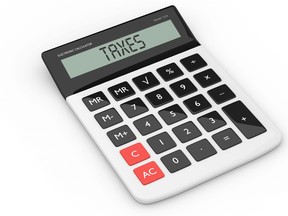At $75,000 in income, Albertans still face the ninth-highest combined (federal and provincial) income tax rate out of 61 Canadian provinces and U.S. states.

Article content
In its recent budget, the Smith government delivered on its promise to reduce the tax rate for all personal income up to $60,000. This is expected to save Albertans up to $750 annually.
Advertisement 2
Article content
But the government shouldn’t stop there.
Article content
Recommended Videos
Article content
At $75,000 in income, Albertans still face the ninth-highest combined (federal and provincial) income tax rate out of 61 Canadian provinces and U.S. states. And due to tax hikes at the provincial and federal level over the past decade, Alberta’s top combined income tax rate is 48% (10th-highest in Canada and the U.S.).
Higher taxes a problem
Of course, higher tax rates mean Alberta workers get to keep less of their hard-earned money. But higher rates are also a problem for other reasons. First, they disincentivize people from working and investing. If your extra work moves you into a higher tax bracket where you face higher rates, you may decide it’s not worth it. This type of disincentive for workers hurts the province’s economic growth. Second, high taxes make it harder to attract doctors, engineers, technology workers and other skilled and mobile workers who help fuel the economy and create jobs.
Article content
Advertisement 3
Article content
So, if the Smith government wants to help the economy grow and help Albertans prosper, it should further reduce income taxes.
For an example of success, it could learn from B.C., which in the early 2000s reduced personal income tax rates by 25% (on average). The resulting additional economic activity generated additional tax revenue that offset much of the cost to B.C.’s treasury. In fact, the sweeping income tax reductions reduced government revenue by less than 2% by the fifth year of the reform.
In other words, at the expense of only a small revenue loss, the B.C. government set the stage for more than a decade of widespread prosperity in the province.
Alberta could go further
Closer to home, the Alberta government under Premier Ralph Klein moved to a single income rate tax of 10% in 2001. This earned Alberta the lowest top combined personal income tax rate in North America and helped give the province a powerful tax advantage that made it very attractive for skilled workers and investment. However, the Notley government in 2015 replaced this single-rate system with five brackets including a top rate of 15%.
Advertisement 4
Article content
According to a recent analysis, if the Smith government reintroduced a single-rate tax — this time, at 8% — Alberta would once again have one of the lowest top combined tax rates in Canada and the U.S. and save affected taxpayers more than $1,500 per year (on average).
Read More
-

HILL: CPP example of Alberta’s outsized contribution to Canada
-

HILL & THOMPSON: Alberta home-building needs boost
For much of recent history, Alberta’s tax system has been highly competitive in North America. But personal income tax hikes at the provincial and federal level have badly undermined that competitiveness. The Smith government can help bolster the province’s economic prospects by building on its recent tax cuts and introduce a more ambitious tax reform package designed to drive economic growth and help workers prosper.
Ben Eisen is a senior fellow at the Fraser Institute, Tegan Hill is director of Alberta policy at the Fraser Institute.
Article content

